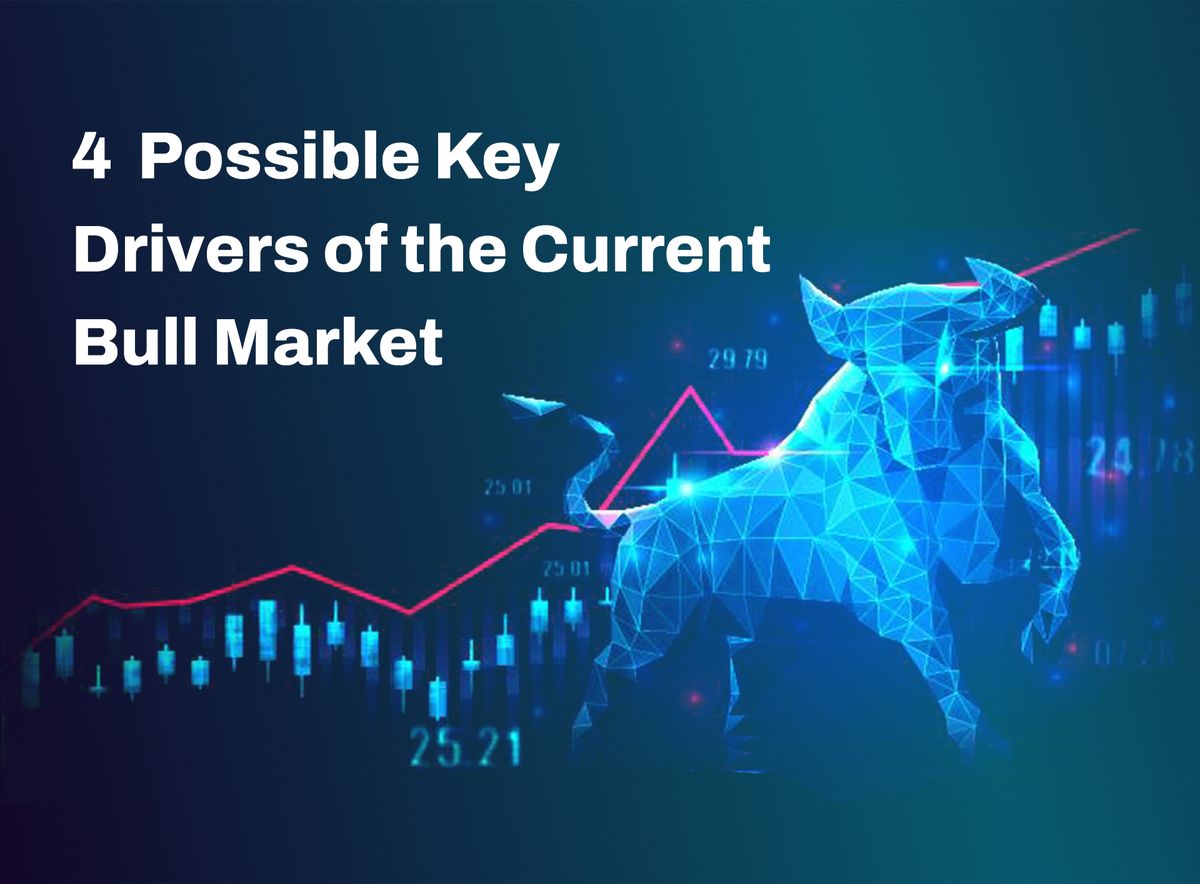4 Possible Key Drivers of the Current Bull Market
What’s fueling the latest crypto bull run? Here are four major factors driving market growth and what they mean for traders and investors.

Table of Contents
- All-Time Highs of Popular Cryptocurrencies in the Last Bull Run
- What is driving the current 2024 crypto bull run?
- The Approval of Bitcoin ETFs By The US Securities and Exchange Commission (SEC)
- Investment Firms and Corporations are Buying Cryptocurrency
- Bitcoin is Being Seriously Considered as a Retirement Fund Option
- More Regulatory Clarity Is Being Provided
- Extra Driving Factor: The Coming Bitcoin Halving
The last crypto bull market before the current one we are experiencing was in 2021 when Bitcoin and other cryptocurrencies like Ether, BNB, Litecoin, Solana and Doge hit all-time highs.
All-Time Highs of Popular Cryptocurrencies in The Last Bull Run of 2021
In the simplest terms, the bull market is one in which there is a positive or upward trend in the prices of cryptocurrencies. It could also mean an anticipated increase in the prices of cryptocurrencies.
February 2024 started the crypto rally that ushered in the current bull market. And on March 5, 2024, Bitcoin, the top cryptocurrency, briefly hit $69,170.63, breaking its previous 2021 All-Time High.
What is driving the current 2024 crypto bull run?
Several factors are driving the current bull run, and these are four of the most important ones:
1. The Approval of Bitcoin ETFs By The US Securities and Exchange Commission (SEC)
The US Securities and Exchange Commission (SEC) approved the listing of the first spot bitcoin exchange-traded funds (ETFs) on January 11, 2024.
A Bitcoin ETF is an exchange-traded fund that tracks the price of Bitcoin. Investing in a Bitcoin ETF allows investors to gain exposure to Bitcoin without investing in the currency directly. It's essentially an investment fund that enables you to buy and sell Bitcoin shares on a stock exchange like you would buy and sell an Amazon or Tesla share.
A total of 11 ETFs featuring a diverse group of sponsors were cleared for listing by the SEC. Established players like Fidelity and Invesco and digital-focused newcomers such as Grayscale and Ark Invest are among the sponsors.
The SEC's approval came after a period of anticipation and legal battles. This development was seen as a significant milestone in the cryptocurrency market, with expectations of attracting new crypto enthusiasts, traders and institutional investors. And true to expectations, it has contributed significantly to getting the crypto market going from bear conditions to bull prices.
2. Investment Firms and Corporations are Buying Cryptocurrency
Institutional buying refers to large entities like investment firms or corporations purchasing significant amounts of cryptocurrency assets.
One notable development driving this institutional interest is the approval of spot exchange-traded Funds (ETFs) for Bitcoin. As mentioned earlier, these ETFs provide a regulated and convenient way for institutions to buy Bitcoin and offer these assets to their customers and clients.
To give you an idea of the scale of this institutional interest, spot ETF options are acquiring around ten times the amount of Bitcoin mined during the same period. This massive inflow of capital into Bitcoin through these ETF products shows the strong demand and trading volume from institutional investors.
Moreover, the fact that roughly 80% of Bitcoin's total supply has not been moved in the last six months indicates a limited new supply entering the market. This scarcity, combined with growing institutional demand, has created a high demand for Bitcoin. At the same time, the available new supply remains constrained.
3. Bitcoin is Being Seriously Considered as a Retirement Fund Option
Previously, the process of including Bitcoin or other cryptocurrencies in retirement accounts was complex and unfamiliar to most mainstream investors. Options were limited, often involving setting up a self-directed Individual Retirement Account (IRA) or using similarly niche products.
With the approval and legitimacy that ETF products bring, it's becoming increasingly likely that financial advisors and retirement funds will start recommending these cryptocurrency investment options to their clients.
The news that financial giant Morgan Stanley is exploring spot Bitcoin ETFs for its clients adds more weight to the legitimacy of cryptocurrency across the board. Furthermore, this move could open up a potential market of $150 billion in assets under management for the institution.
As more institutions, like Morgan Stanley, consider incorporating Bitcoin ETFs into their offerings, it shows a broader acceptance of cryptocurrencies in traditional financial settings.
The potential expansion into registered investment advisor (RIA) networks could further boost Bitcoin and the wider crypto-asset market, as we are seeing with rising prices, attracting additional institutional interest and investment.
4. More Regulatory Clarity Is Being Provided
Recent advancements in regulatory clarity have helped address critical obstacles that have hindered larger and more consistent investment in Bitcoin and other crypto assets.
For instance, accounting rulings now guide organisations to account for and disclose their crypto asset holdings, enhancing transparency and making financial reporting more comparable.
In addition, the Securities and Exchange Commission (SEC), which previously cast a shadow of uncertainty over the crypto industry with regulatory actions, has faced setbacks in its attempts to regulate the space. Court rulings and Congressional hearings have tempered the SEC's regulatory ambitions, providing a more stable environment for investors.
Furthermore, efforts by the Internal Revenue Service (IRS) to clarify tax implications related to crypto investments have simplified tax reporting for investors of all sizes, encouraging compliance and easing past taxation concerns.
Extra Driving Factor: The Coming Bitcoin Halving
Bitcoin's programmed supply-halving events happen roughly every four years.
The purpose of halving is to control the supply of Bitcoin, making it more scarce over time. As per the Bitcoin protocol, there will only ever be 21 million Bitcoins in existence.
Halving ensures that the issuance of new Bitcoins slows down over time until the maximum supply is reached. This scarcity is one reason why Bitcoin is often compared to gold, as both assets have a limited supply.
Bitcoin halvings have a history of leading to notable price surges because they reduce inflation rates and change supply dynamics.
The next halving event is anticipated to occur in April 2024 and could have an (even more significant ) impact on cryptocurrency prices.
Disclaimer: This article was written to provide guidance and understanding. It is not an exhaustive article and should not be taken as financial advice. Obiex will not be held liable for your investment decisions.



